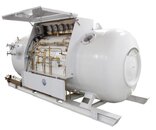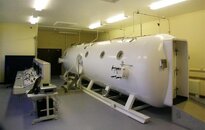[h=3]Oxygen supply[/h] In today's larger multiplace chambers, both patients and medical staff inside the chamber breathe from either "oxygen hoods" – flexible, transparent soft plastic hoods with a seal around the neck similar to a
space suit helmet – or tightly fitting
oxygen masks, which supply pure oxygen and may be designed to directly exhaust the exhaled gas from the chamber. During treatment patients breathe 100% oxygen most of the time to maximise the effectiveness of their treatment, but have periodic "air breaks" during which they breathe room air (21% oxygen) to minimize the risk of
oxygen toxicity. The exhaled gas must be removed from the chamber to prevent the build up of oxygen, which could present a fire risk. Attendants may also breathe oxygen to reduce their risk of
decompression sickness. The pressure inside a hard chamber is increased by opening valves allowing high-pressure air to enter from
storage cylinders, which are filled by an
air compressor. A soft chamber may be pressurised directly from a compressor.
Smaller "monoplace" chambers can only accommodate the patient, and no medical staff can enter. The chamber may be pressurised with pure oxygen or compressed air. If pure oxygen is used, no oxygen breathing mask or helmet is needed, but the cost of using pure oxygen is much higher than that of using compressed air. If compressed air is used then an oxygen mask or hood is needed as in a multiplace, hard chamber. In monoplace chambers that are compressed with pure oxygen a mask is available to provide the patient with "air breaks," periods of breathing normal air (21% oxygen), in order to reduce the risk of hyperoxic seizures. In soft chambers, using compressed air and a mask supplying 96% oxygen, no air breaks are necessary as there is negligible risk of oxygen toxicity because of relatively low oxygen partial pressures and the short duration of treatment.






